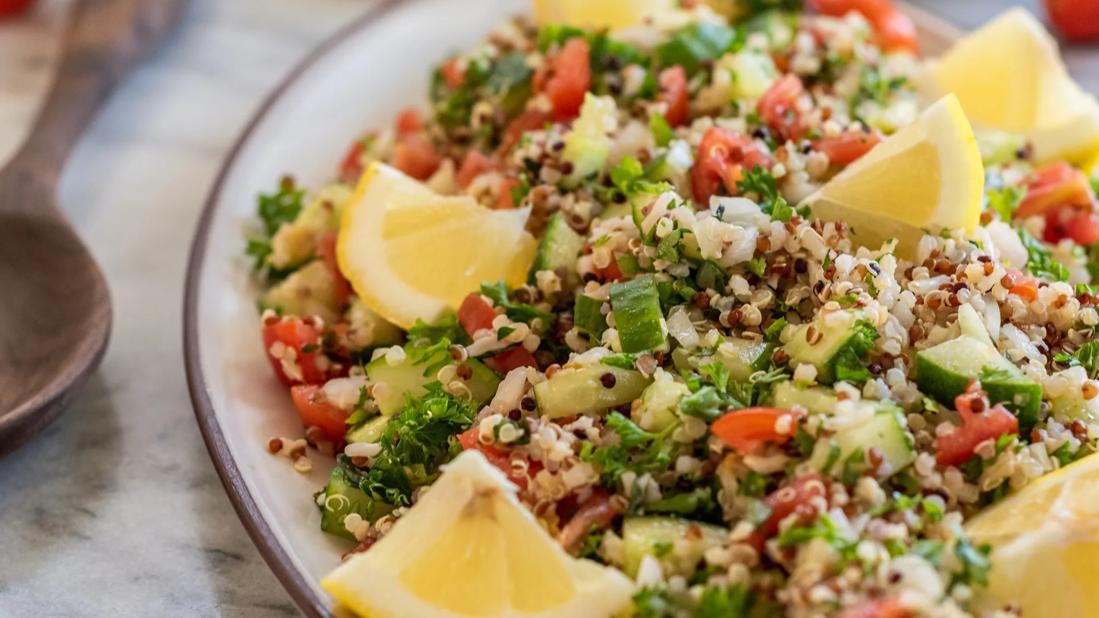Recipe: Quinoa Tabbouleh (Gluten-Free)
Gluten-free quinoa stars in this tasty tabbouleh

This tabbouleh uses quinoa instead of the traditional bulgur to make it gluten-free. This ancient Aztec grain-like seed is packed with protein and has a nutty flavor. Be sure to buy it pre-rinsed or rinse it first to prevent a bitter flavor.
Ingredients
- 1 1/2 cups cooked quinoa
- 2 cups seeded and diced tomatoes
- 1 cup diced seeded cucumber
- 1 cup chopped fresh flat-leaf parsley
- 1/2 cup chopped onion
- 3 tablespoons chopped fresh mint
- 1 large garlic clove, chopped
- Juice of 1 fresh lemon
- 2 tablespoons olive oil
- 1/2 teaspoon black pepper
Directions
1. Combine quinoa, tomatoes, cucumber, parsley, onion, mint, garlic and black pepper.
2. Mix lemon juice and olive oil and add to tabbouleh.
3. Toss until well mixed.
Ingredient health benefits
- Quinoa. An ancient grain, quinoa is a vegan-friendly complete protein and rich in fiber, which keeps your stomach satisfied for longer. It has B vitamins like pyridoxine (B6) and folate (B9) to help your body convert the food you eat into energy you can use. These vitamins also work with iron to maintain healthy blood cells, and your bones and teeth will love the manganese, magnesium and phosphorus.
- Tomatoes. It’s easy to overlook such a common ingredient, but tomatoes are a worthy addition to any recipe. Potassium and the antioxidants lycopene and beta-carotene provide powerful heart health benefits. Together, they help regulate your blood pressure, lower cholesterol and suppress unwanted inflammation. Vitamin C and vitamin K also help reduce inflammation throughout your body and support your blood cells.
- Cucumber. Adding more than just a crunch to your salad, cucumbers are a source of vitamin K, which helps your bones stay in top shape. They’re also 97% water, so they provide hydration while you eat, which also helps your digestive system stay on tract (I mean track). There’s also fiber for a happy gut and to help decrease your risk of colon cancer. Speaking of which, studies suggest that a naturally occurring compound called cucurbitacin B (CuB) may even have anti-cancer properties.
- Parsley. This popular garnish is a natural diuretic, so it helps your body eliminate excess water and fluids in the usual way. Parsley is also high in inflammation-lowering flavonoids.
- Onions. Like tomatoes, onions aren’t one of those veggies that jump out at you in the produce section. But they’re loaded with prebiotics and fiber to promote good digestion, while vitamin C and flavonoids fight free radicals that can damage your cells. A flavonoid called quercetin may also boost your gut health by making it harder for harmful bacteria to grow there.
- Garlic. The trademark aroma and flavor aren’t the only potent properties! Eating garlic regularly may contribute to lower blood pressure. It might also help fortify your immune system if your eating habits also include lots of fruits and veggies. For these reasons, some consider it a superfood.
- Olive oil. This cooking oil has made quite a splash for its many benefits. Olive oil is packed with fat-soluble vitamins that reduce inflammation and sustain essential body systems like your vision and bones. Heart-helpful unsaturated fats help lower your “bad” (LDL) cholesterol and raise your “good” (HDL) cholesterol. What’s more, olive oil is high in anti-inflammatory polyphenols and other compounds that may help keep cancer at bay.
Nutrition information (per serving)
Makes 6 servings
Calories: 131
Protein: 3 g
Carbohydrate: 17.5 g
Fat: 5.5 g
Saturated fat: 0.7 g
Dietary fiber: 3 g
Sodium: 144 mg
Calcium: 75.6 mg